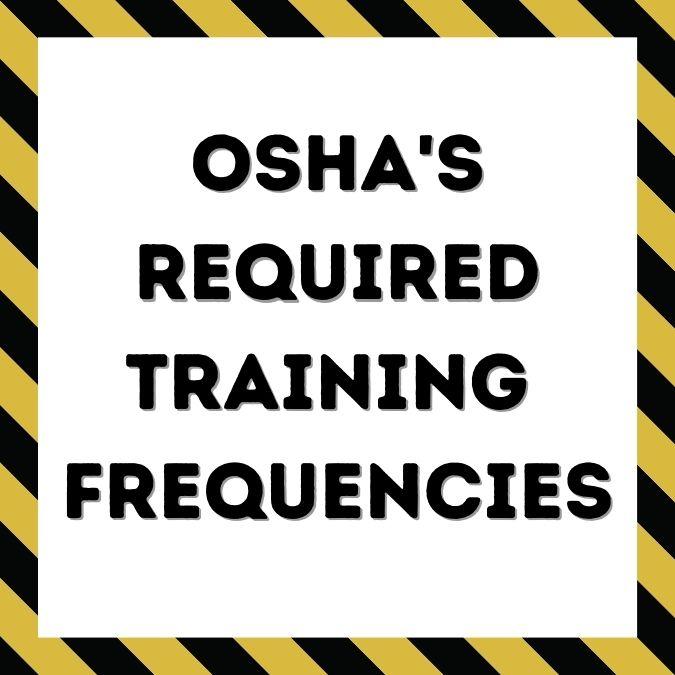In today’s fast-paced workforce, it’s important to stay up-to-date on safety regulations and procedures. That’s why OSHA, the Occupational Safety and Health Administration, has set certain training frequencies for certain industries. It is crucial for employers to understand and comply with these regulations to ensure the safety of their employees and avoid penalties.
First, let’s take a look at the general industry. OSHA requires that all employees receive safety training at least once a year. This training must cover topics such as emergency action plans, fire prevention plans, and hazardous chemical exposure. This requirement is in place because a well-informed workforce is a safe workforce. By providing training on emergency procedures, employers can ensure that their employees know how to respond in the event of an emergency, which can help save lives. Similarly, by providing training on fire prevention and hazardous chemical exposure, employers can help prevent accidents and injuries.
The construction industry has a slightly different set of requirements. OSHA requires that all employees receive safety training within six months of being hired, and then at least once a year thereafter. This training must cover topics such as fall protection, scaffold safety, and excavation safety. The construction industry is known for having a higher risk of accidents and injuries than other industries, so it is crucial that employees are properly trained on how to stay safe. By providing training on fall protection, scaffold safety, and excavation safety, employers can help prevent accidents and injuries on the job site.
For those who work in the maritime industry, OSHA requires that all employees receive safety training at least once every five years. This training must cover topics such as personal protective equipment, hazardous materials, and emergency evacuation procedures. This requirement is in place because maritime work can be particularly dangerous, and it is crucial that employees are properly trained on how to stay safe. By providing training on personal protective equipment, hazardous materials, and emergency evacuation procedures, employers can help prevent accidents and injuries.
In addition to these annual, six-month, and five-year training frequencies, OSHA also requires that employers provide additional training for certain specific hazards. For example, if an employee is working with hazardous chemicals, they must receive training on how to safely handle and store those chemicals. This requirement is in place because working with hazardous chemicals can be particularly dangerous, and it is crucial that employees are properly trained on how to handle these chemicals safely. By providing training on how to safely handle and store hazardous chemicals, employers can help prevent accidents and injuries.
It’s important to note that these training frequencies and requirements are just the bare minimum. Employers are encouraged to provide additional training as needed to ensure the safety of their employees. This is because safety is a continuous process, it’s not something that can be achieved once and then forgotten about. Employers should always be looking for new ways to improve safety in the workplace and providing additional training is one way to do that.
In order to stay compliant with OSHA’s training regulations, employers should keep detailed records of all safety training provided to employees. This includes the date of the training, the topics covered, and the names of the employees who attended. This is important because OSHA may conduct audits to check compliance, and employers must be able to provide proof that they have provided the required training to their employees.
Failure to comply with OSHA’s training regulations can result in hefty fines and penalties. Not only is it important to protect the safety of your employees, but it also makes good business sense to stay in compliance with regulations. By providing the required training and staying in compliance, employers can avoid costly fines and penalties. Additionally, a safe workplace can lead to lower workers compensation insurance, and employee absenteeism, which can lead to a more productive and penalties, and instead, focus on creating a safe and productive workplace. Employers who fail to comply with OSHA’s regulations also risk damaging their reputation, which can be detrimental to their business.
In conclusion, OSHA’s required training frequencies are put in place to ensure the safety of employees in different industries. Employers should make sure they understand the specific requirements for their industry and provide training accordingly. Additionally, it’s important to keep detailed records of all safety training provided to employees and to provide additional training as needed. With the right focus on safety training, employers can create a safer workplace for everyone. It is essential for employers to prioritize safety, not just for compliance purposes but for the well-being of their employees. By providing the necessary safety training, employers can create a culture of safety that will help prevent accidents and injuries, and ultimately lead to a more productive and successful business.










